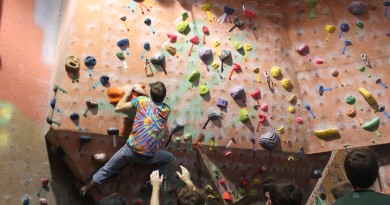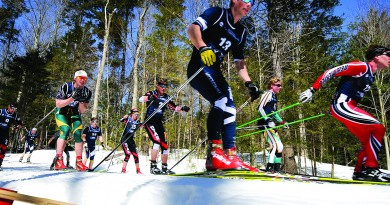On The Cashmere Trail: Skida Mountain Bikes Nepal
Four women explore Nepal on mountain bikes, in pursuit of goats.
It was the highest point of elevation, the moment the mountain bikers ran into the yak herder, that Corinne Prevot remembers best. “We had climbed for several days and finally reached this saddle,” says the 26-year-old apparel designer from Burlington. “We were looking down on the village where we had stayed the past few nights and you could see the river we were headed to unfolding down the valley.”
The river, the Kali Gandaki, flows into what some consider the deepest gorge in the world. Flowing from 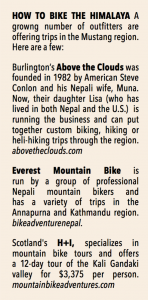 its source near the Tibetan border, the river carves the earth between two of the tallest mountains in the world, passing 18,278 feet below the snowcapped peak of Annapurna. The gorge has been a trade route between India and Tibet for hundreds of years.
its source near the Tibetan border, the river carves the earth between two of the tallest mountains in the world, passing 18,278 feet below the snowcapped peak of Annapurna. The gorge has been a trade route between India and Tibet for hundreds of years.
That day this past March, Prevot and three friends were on a trade route of their own, in search of the Chyangra goats, the source of prized cashmere.
Prevot started Skida, a hat and scarf company, in 2008 when she was a ski racer at Burke Mountain Academy, stitching hats for her Nordic team and then for friends. As a student at Middlebury College, she grew the business, using stretchy fabrics and bright colors and patterns. In 2011, she did a study abroad program in Nepal and became fascinated with cashmere.
“It’s an amazing natural fiber, and one of the warmest,” she says. It’s also the mainstay of a farming and weaving industry in Nepal. After graduating from Middlebury in 2013, Prevot was drawn back to Nepal. She returned to the cashmere factory she had seen the year before and in 2014 launched her first cashmere line, produced in Kathmandu.
This trip was, partially, business—a farm-to-fiber quest to see how her products are sourced. “I’d seen the factories but I wanted to meet the people who herd the goats up in the mountains,” says Prevot. She and Julia Van Raalte, a former ski racer who had been living in Kathmandu, scouted the route last fall. This past March, Prevot, Van Raalte, fellow Burke Mountain Academy grad, Katy Kirkpatrick, from Shelburne, and Middlebury grad Lani Bruntz, met up in Kathmandu.
After riding in the valley to acclimatize, they took multiple ights and a day-long bus ride to reach the Mustang Region, home of the Himalaya’s prized Chyangra mountain goats and the start of their bike trek.
“There’s a growing mountain bike culture in this area,” says Prevot, who worked with guides she knew to map out a route. “Over six days, we’d ascend about 5,000 feet and descend 10,000 feet covering over 60 miles. The first two days would be a gravel Jeep road with a few single-track cut-offs,” Kirkpatrick wrote on a blog that appeared on kitsbow.com.
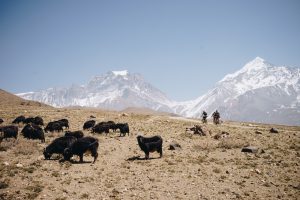
“Nothing earth- shattering in terms of trail conditions, but to be out in a landscape resembling the moon felt so far away from familiarity and made each pedal stroke feel exhilarating.”
Villages were strung along the route and at night the women would stay at tea houses. “Our hosts often served the traditional Nepali dish, dal bhat–steamed rice with a lentil soup,” says Prevot. The hostels were simple, and some had hot water, but they were shelters. At night the temperatures would plummet to the 30s and 40s before the intense sun would warm the altitude-thin air back to 60 degrees.
Both Prevot and Van Raalte knew enough Nepali to converse with their hosts and their porter, Suresh. They had met him on a ride they did last fall, and he had agreed to carry their packs between villages by Jeep. “People were excited to see four women on mountain bikes but they kept telling us, ‘No no, 30 miles is too far, you can’t ride that in a day,’” says Prevot with a laugh. All four of the women are ex ski racers—Prevot and Bruntz, Nordic racers, and Kirkpatrick and Van Raalte, alpine. “It was really fun to ride with these strong women,” says Prevot.
After assembling their bikes at the tiny Jomsom airport, the four climbed from 9,000 feet to 12,500 feet before dropping into the main descent, a winding singletrack used by herders. “Our mission was to ride up to Kagbeni on trails. Goats are kept in the villages at night and then graze up in the mountains during the day. In one village, we found two different herds—some were used for meat, some were sold for sacrificial festivals,” Prevot says.
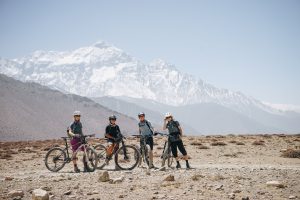
The goats provide meat, milk and cashmere. “Cashmere is from the protected under fiber, and the farmers harvest it simply by brushing the goats’ underbelly. This means it’s a sustainable, low-impact fiber and they can use the goats in multiple ways,” she says.
Cashmere was once one of Nepal’s main exports but now India and China mass produce it, which allows the goat herders to trade north but makes it harder for the Nepali manufacturers to compete.
Leaving Kagbeni, the women continued on the climb towards the pass. “It was at that high point when we met the yak herder and I think he was as surprised as we were,” Prevot remembers. “We had incredible views all around of snowcapped mountains
and a long, winding descent below. That’s the moment that sticks in my mind.”
After exchanging a few words with the herder, the four had a screaming descent down toward the river and back down a dusty road to the end of the route, Beni, at 3,000 feet. They then hopped a bus to Pokhara.
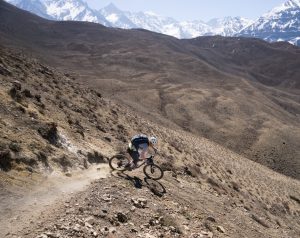
“You go through so many different eco systems. It’s really dry and arid alpine, then you come to treeline and pine forests and then it switches to a subtropical climate,” Prevot says. “This was my fourth trip and it’s exciting to see Nepal start to become more accessible for mountain biking. My goal is to keep going back.”
Skida’s cashmere line bears hangtags that read “Designed in Vermont, produced in Nepal.” To see the line, visit skida.com.



